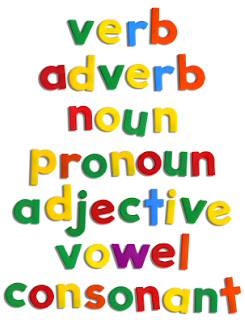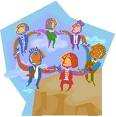To download the lesson plan click here!! :D
Sunday, May 29, 2011
Sunday, May 22, 2011
Box 5.2 Question for discussion

Vocabulary presentation techniques
1. Some techniques are more popular than others. What are they and can you account for their popularity?
Maybe the most popular techniques are definition, example and illustration because for the teacher is easier to teach with these techniques, the others need more participation of the teacher, for example demonstration.
2. Are there techniques that are particularly appropriate for the presentation of certain types of words?
Yes, for example the illustration is better for children; they motive with pictures on the board and learn words accorded with the image. Another case, with definition the students know what is the word and, if the teacher includes the illustration they learn the definition according to the picture and related with their own knowledge.
3.- Are there techniques which are likely to be more, or less, appropriate for particular learner populations (young/adult, beginner/advanced, different background cultures)?
Yes, for example illustration and demonstration are more appropriate for children, capture their attention with images or mime. Definition, examples or synonyms are more appropriate for youngers or adults because sometimes they know a little more the second language.
4. - Do you, as an individual, find that you prefer some kinds of techniques and tend to avoid others? Which? And Why?
I prefer example, description and associated ideas. Because with examples we know more words related with one definition. In the case of description I like because the teacher can teach with characteristics of the word, qualities and we imagine or related with our knowledge and then we associated ideas with our environment and reflect the experiences with classmates.
I don’t prefer translation and antonyms because I prefer to learn with techniques more didactics. That includes the interaction of the student and the association of the real meaning of the word.
Sunday, May 15, 2011
Teaching pronunciation...
We have a homework and is related with teaching pronunciation.
And what is pronunciation?
Pronunciation refers to the way a word or a language is spoken, or the manner in which someone utters a word. If one is said to have "correct pronunciation", then it refers to both within a particular dialect.
A word can be spoken in different ways by various individuals or groups, depending on many factors, such as: the area in which they grew up, the area in which they now live, if they have a speech or voice disorder, their ethnic group, their social class, or their education. (http://en.wikipedia.org/wiki/Pronunciation)
And what is pronunciation?
Pronunciation refers to the way a word or a language is spoken, or the manner in which someone utters a word. If one is said to have "correct pronunciation", then it refers to both within a particular dialect.
A word can be spoken in different ways by various individuals or groups, depending on many factors, such as: the area in which they grew up, the area in which they now live, if they have a speech or voice disorder, their ethnic group, their social class, or their education. (http://en.wikipedia.org/wiki/Pronunciation)
Now, I show you my lesson plan... (phonetics lesson!!) :D
To download the lesson plan click here :)
See you !!
Observation and discussion
Now I show you the real situation related with the topic “Classroom Interaction”.
Observe one or two lessons, and note down the types of interaction you saw, using your own list or that shown in Box 16. 1. After the observation, discuss or reflect on the following questions:
l. Was there one particular type of interaction that seemed to predominate?
Teacher talk – Individual work
Because the teacher explain, present the new topic and then she gives a task for students and they work individually.
II. Did teacher activity predominate? Or student activity?
Or was the Interaction more or less balanced?
Sometimes the interaction is more or less balanced between teacher and students, but most of the time the teacher has predominate activity. Because she talks, explain the new content and give a task for students. Sometimes, only explain the material or topic, but the students don’t interact with their own knowledge.
III. How appropriate did you think the chosen interaction patterns were for the teaching objectives in the different activities?
For the teaching objectives in the different activities, I think the interaction patterns used are not very appropriate; maybe teacher could include group work or collaboration because in the class there are students with more skills that could help others in group tasks.
Well, you can see that the topic is very important for teachers and students. Because with different types of interaction we can motivate to students and realise a very interesting class. Is important the interaction with students, because they are the main actors in the process (learning process).
See you in the next post... ;)
Saturday, May 14, 2011
Classroom Interaction !¡
Patterns of classroom interaction
In last class, we saw a new topic and now I explain that.
The most common type of classroom interaction is known like "IRF": Initiation – Response – Feedback, where the teacher ask questions and one of the students answer, then the teacher gives feedback, maybe comment the answer or correction and then he or she ask another question… and so on.
Classifying forms of interaction:
TT: Teacher very active, students only receptive
T: Teacher active, students mainly receptive
TS: Teacher and students fairly equally active
S: Students active, teacher mainly receptive
SS: Students very active, teacher only receptive
(Then, I show you my observation in a real class related with this topic)
Also, we saw a different interaction patterns:
Group work
Closed-ended teacher questioning
Individual work
Choral responses
Collaboration
Student initiates, teacher answers
Full-class interaction
Teacher talk
Self-access
Open-ended teacher questioning
And we comments “reasons for questioning”
- To check the knowledge of each student
- To gain confidence
- To practice oral expression in L2.
- To check comprehension
- To increase motivation
- Etc. etc.
This topic is very interesting, no? It's necessary to study more about that, for our development like a teacher. Because is important to know the types that I could use for a better interaction with our students in class.
Well... see you in next post! :)
Subscribe to:
Posts (Atom)










